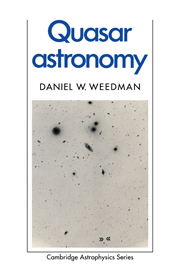1 - The technology
Published online by Cambridge University Press: 18 December 2009
Summary
Introduction
In the chapters that follow, nearly a quarter century of intensive research and substantial progress in understanding the quasars will be summarized. From the perspective of an astronomer, it would be satisfying to report that this progress was primarily attributable to the cleverness and diligence of astronomers in attacking the problem. To be honest, however, most of the progress should be credited to the engineers and physicists who have developed the tools that allow our wide ranging probes into the mysteries of quasars. Trying to understand quasars forced astronomers into realizing that observations must extend over the broadest possible spectral coverage, that we must learn how to use X-ray, ultraviolet, optical, infrared and radio astronomy. It is now possible for an individual astronomer to have access to telescopes that access all of these spectral regions, and I am convinced that the definition of a ‘good’ observer in the next few decades will weigh heavily on the ability to be comfortable with all of these techniques. To realize how much this has changed the science of astronomy, one need only recall that the analogously important talents in 1960 were the ability to work efficiently at night, to withstand cold temperatures, and to develop photographic emulsions without accidently turning on the lights. At that time, the technically sophisticated astronomer was one who could use a photomultiplier tube.
- Type
- Chapter
- Information
- Quasar Astronomy , pp. 1 - 18Publisher: Cambridge University PressPrint publication year: 1986



